New York, Susquehanna and Western Railway
The New York, Susquehanna and Western Railway (reporting mark NYSW) (or New York, Susquehanna and Western Railroad and also known as the Susie-Q or the Susquehanna) is a Class II American freight railway operating over 400 miles (645 km) of track in the northeastern U.S. states of New York, Pennsylvania, and New Jersey.[1][2]
 | |||||||||||||||||||||||||||||||||||||||||||||||||||||||||||||||||||||||||||||||||||||||||||||||||||||||||||||||||||||||||||||||||||||||||||||||||||||||||||||||||||||||||||||||||||||||||||||||||||||||||||||||||||||||||||||||||||||||||||||||||||||||||||||||||||||||||||||||||||||||||||||||||||||||||||||||||||||||||||||||||||||||||||||||||||||||||||||||||||||||||||||||||||||||||||||||||||||||||||||||||||||||||||||||||||||||||||||||||||||||||||||||||||||||||||||||||||||||||||||||||||||||||||||||||||||||||||||||||||||||||||||||||||||||||||||||||||||||||||||||||||||||||||||||||||||||||||||||||||||||||||||||||||||||||||||||||||||||||||||||||||||||||||||||||||||||||||||||||||||||||||||||||||||||||||||||||||||||||||||||||||||||||||||||||||||||||||||||||||||||||||||||||||||||||||||||||||||||||||||||||||||||||||||||||||||||||||||||||||||||||||||||||||||||||||||||||||||||||||||||||||||||||||||||||||||||||||||||||||||||||||||||||||||||||||||||||||||||||||||||||||||||||||||||||||||||||||||||||||||||
 | |||||||||||||||||||||||||||||||||||||||||||||||||||||||||||||||||||||||||||||||||||||||||||||||||||||||||||||||||||||||||||||||||||||||||||||||||||||||||||||||||||||||||||||||||||||||||||||||||||||||||||||||||||||||||||||||||||||||||||||||||||||||||||||||||||||||||||||||||||||||||||||||||||||||||||||||||||||||||||||||||||||||||||||||||||||||||||||||||||||||||||||||||||||||||||||||||||||||||||||||||||||||||||||||||||||||||||||||||||||||||||||||||||||||||||||||||||||||||||||||||||||||||||||||||||||||||||||||||||||||||||||||||||||||||||||||||||||||||||||||||||||||||||||||||||||||||||||||||||||||||||||||||||||||||||||||||||||||||||||||||||||||||||||||||||||||||||||||||||||||||||||||||||||||||||||||||||||||||||||||||||||||||||||||||||||||||||||||||||||||||||||||||||||||||||||||||||||||||||||||||||||||||||||||||||||||||||||||||||||||||||||||||||||||||||||||||||||||||||||||||||||||||||||||||||||||||||||||||||||||||||||||||||||||||||||||||||||||||||||||||||||||||||||||||||||||||||||||||||||||
| Overview | |||||||||||||||||||||||||||||||||||||||||||||||||||||||||||||||||||||||||||||||||||||||||||||||||||||||||||||||||||||||||||||||||||||||||||||||||||||||||||||||||||||||||||||||||||||||||||||||||||||||||||||||||||||||||||||||||||||||||||||||||||||||||||||||||||||||||||||||||||||||||||||||||||||||||||||||||||||||||||||||||||||||||||||||||||||||||||||||||||||||||||||||||||||||||||||||||||||||||||||||||||||||||||||||||||||||||||||||||||||||||||||||||||||||||||||||||||||||||||||||||||||||||||||||||||||||||||||||||||||||||||||||||||||||||||||||||||||||||||||||||||||||||||||||||||||||||||||||||||||||||||||||||||||||||||||||||||||||||||||||||||||||||||||||||||||||||||||||||||||||||||||||||||||||||||||||||||||||||||||||||||||||||||||||||||||||||||||||||||||||||||||||||||||||||||||||||||||||||||||||||||||||||||||||||||||||||||||||||||||||||||||||||||||||||||||||||||||||||||||||||||||||||||||||||||||||||||||||||||||||||||||||||||||||||||||||||||||||||||||||||||||||||||||||||||||||||||||||||||||||
|---|---|---|---|---|---|---|---|---|---|---|---|---|---|---|---|---|---|---|---|---|---|---|---|---|---|---|---|---|---|---|---|---|---|---|---|---|---|---|---|---|---|---|---|---|---|---|---|---|---|---|---|---|---|---|---|---|---|---|---|---|---|---|---|---|---|---|---|---|---|---|---|---|---|---|---|---|---|---|---|---|---|---|---|---|---|---|---|---|---|---|---|---|---|---|---|---|---|---|---|---|---|---|---|---|---|---|---|---|---|---|---|---|---|---|---|---|---|---|---|---|---|---|---|---|---|---|---|---|---|---|---|---|---|---|---|---|---|---|---|---|---|---|---|---|---|---|---|---|---|---|---|---|---|---|---|---|---|---|---|---|---|---|---|---|---|---|---|---|---|---|---|---|---|---|---|---|---|---|---|---|---|---|---|---|---|---|---|---|---|---|---|---|---|---|---|---|---|---|---|---|---|---|---|---|---|---|---|---|---|---|---|---|---|---|---|---|---|---|---|---|---|---|---|---|---|---|---|---|---|---|---|---|---|---|---|---|---|---|---|---|---|---|---|---|---|---|---|---|---|---|---|---|---|---|---|---|---|---|---|---|---|---|---|---|---|---|---|---|---|---|---|---|---|---|---|---|---|---|---|---|---|---|---|---|---|---|---|---|---|---|---|---|---|---|---|---|---|---|---|---|---|---|---|---|---|---|---|---|---|---|---|---|---|---|---|---|---|---|---|---|---|---|---|---|---|---|---|---|---|---|---|---|---|---|---|---|---|---|---|---|---|---|---|---|---|---|---|---|---|---|---|---|---|---|---|---|---|---|---|---|---|---|---|---|---|---|---|---|---|---|---|---|---|---|---|---|---|---|---|---|---|---|---|---|---|---|---|---|---|---|---|---|---|---|---|---|---|---|---|---|---|---|---|---|---|---|---|---|---|---|---|---|---|---|---|---|---|---|---|---|---|---|---|---|---|---|---|---|---|---|---|---|---|---|---|---|---|---|---|---|---|---|---|---|---|---|---|---|---|---|---|---|---|---|---|---|---|---|---|---|---|---|---|---|---|---|---|---|---|---|---|---|---|---|---|---|---|---|---|---|---|---|---|---|---|---|---|---|---|---|---|---|---|---|---|---|---|---|---|---|---|---|---|---|---|---|---|---|---|---|---|---|---|---|---|---|---|---|---|---|---|---|---|---|---|---|---|---|---|---|---|---|---|---|---|---|---|---|---|---|---|---|---|---|---|---|---|---|---|---|---|---|---|---|---|---|---|---|---|---|---|---|---|---|---|---|---|---|---|---|---|---|---|---|---|---|---|---|---|---|---|---|---|---|---|---|---|---|---|---|---|---|---|---|---|---|---|---|---|---|---|---|---|---|---|---|---|---|---|---|---|---|---|---|---|---|---|---|---|---|---|---|---|---|---|---|---|---|---|---|---|---|---|---|---|---|---|---|---|---|---|---|---|---|---|---|---|---|---|---|---|---|---|---|---|---|---|---|---|---|---|---|---|---|---|---|---|---|---|---|---|---|---|---|---|---|---|---|---|---|---|---|---|---|---|---|---|---|---|---|---|---|---|---|---|---|---|---|---|---|---|---|---|---|---|---|---|---|---|---|---|---|---|---|---|---|---|---|---|---|---|---|---|---|---|---|---|---|---|---|---|---|---|---|---|---|---|---|---|---|---|---|---|---|---|---|---|---|---|---|---|---|---|---|---|---|---|---|---|---|---|---|---|---|---|---|---|---|---|---|---|---|---|---|---|---|---|---|---|---|---|---|---|---|---|---|---|---|---|---|---|---|---|---|---|---|---|---|---|---|---|---|---|---|---|---|---|---|---|---|---|---|---|---|---|---|---|---|---|---|---|---|---|---|---|---|---|---|---|---|---|---|---|---|---|---|---|---|---|---|---|---|---|---|---|---|---|---|---|---|---|---|---|---|---|---|---|---|---|---|---|---|---|---|---|---|---|---|---|---|---|---|---|---|---|---|---|---|---|---|---|---|---|---|---|---|---|---|---|---|---|---|---|---|---|---|---|---|---|---|---|---|---|---|---|---|---|---|---|---|---|---|---|---|---|---|---|---|---|---|---|---|---|---|---|---|---|---|---|---|---|---|---|---|---|---|---|---|---|---|---|---|---|---|---|---|---|---|---|---|---|---|---|---|---|---|---|---|---|---|---|---|---|---|---|---|---|---|---|---|---|---|---|---|---|---|---|---|---|---|---|---|---|---|---|---|---|---|---|---|---|---|---|---|---|---|---|---|---|
| Headquarters | Cooperstown, New York | ||||||||||||||||||||||||||||||||||||||||||||||||||||||||||||||||||||||||||||||||||||||||||||||||||||||||||||||||||||||||||||||||||||||||||||||||||||||||||||||||||||||||||||||||||||||||||||||||||||||||||||||||||||||||||||||||||||||||||||||||||||||||||||||||||||||||||||||||||||||||||||||||||||||||||||||||||||||||||||||||||||||||||||||||||||||||||||||||||||||||||||||||||||||||||||||||||||||||||||||||||||||||||||||||||||||||||||||||||||||||||||||||||||||||||||||||||||||||||||||||||||||||||||||||||||||||||||||||||||||||||||||||||||||||||||||||||||||||||||||||||||||||||||||||||||||||||||||||||||||||||||||||||||||||||||||||||||||||||||||||||||||||||||||||||||||||||||||||||||||||||||||||||||||||||||||||||||||||||||||||||||||||||||||||||||||||||||||||||||||||||||||||||||||||||||||||||||||||||||||||||||||||||||||||||||||||||||||||||||||||||||||||||||||||||||||||||||||||||||||||||||||||||||||||||||||||||||||||||||||||||||||||||||||||||||||||||||||||||||||||||||||||||||||||||||||||||||||||||||||
| Reporting mark | NYSW | ||||||||||||||||||||||||||||||||||||||||||||||||||||||||||||||||||||||||||||||||||||||||||||||||||||||||||||||||||||||||||||||||||||||||||||||||||||||||||||||||||||||||||||||||||||||||||||||||||||||||||||||||||||||||||||||||||||||||||||||||||||||||||||||||||||||||||||||||||||||||||||||||||||||||||||||||||||||||||||||||||||||||||||||||||||||||||||||||||||||||||||||||||||||||||||||||||||||||||||||||||||||||||||||||||||||||||||||||||||||||||||||||||||||||||||||||||||||||||||||||||||||||||||||||||||||||||||||||||||||||||||||||||||||||||||||||||||||||||||||||||||||||||||||||||||||||||||||||||||||||||||||||||||||||||||||||||||||||||||||||||||||||||||||||||||||||||||||||||||||||||||||||||||||||||||||||||||||||||||||||||||||||||||||||||||||||||||||||||||||||||||||||||||||||||||||||||||||||||||||||||||||||||||||||||||||||||||||||||||||||||||||||||||||||||||||||||||||||||||||||||||||||||||||||||||||||||||||||||||||||||||||||||||||||||||||||||||||||||||||||||||||||||||||||||||||||||||||||||||||
| Locale | New York New Jersey Pennsylvania | ||||||||||||||||||||||||||||||||||||||||||||||||||||||||||||||||||||||||||||||||||||||||||||||||||||||||||||||||||||||||||||||||||||||||||||||||||||||||||||||||||||||||||||||||||||||||||||||||||||||||||||||||||||||||||||||||||||||||||||||||||||||||||||||||||||||||||||||||||||||||||||||||||||||||||||||||||||||||||||||||||||||||||||||||||||||||||||||||||||||||||||||||||||||||||||||||||||||||||||||||||||||||||||||||||||||||||||||||||||||||||||||||||||||||||||||||||||||||||||||||||||||||||||||||||||||||||||||||||||||||||||||||||||||||||||||||||||||||||||||||||||||||||||||||||||||||||||||||||||||||||||||||||||||||||||||||||||||||||||||||||||||||||||||||||||||||||||||||||||||||||||||||||||||||||||||||||||||||||||||||||||||||||||||||||||||||||||||||||||||||||||||||||||||||||||||||||||||||||||||||||||||||||||||||||||||||||||||||||||||||||||||||||||||||||||||||||||||||||||||||||||||||||||||||||||||||||||||||||||||||||||||||||||||||||||||||||||||||||||||||||||||||||||||||||||||||||||||||||||||
| Dates of operation | 1881–present | ||||||||||||||||||||||||||||||||||||||||||||||||||||||||||||||||||||||||||||||||||||||||||||||||||||||||||||||||||||||||||||||||||||||||||||||||||||||||||||||||||||||||||||||||||||||||||||||||||||||||||||||||||||||||||||||||||||||||||||||||||||||||||||||||||||||||||||||||||||||||||||||||||||||||||||||||||||||||||||||||||||||||||||||||||||||||||||||||||||||||||||||||||||||||||||||||||||||||||||||||||||||||||||||||||||||||||||||||||||||||||||||||||||||||||||||||||||||||||||||||||||||||||||||||||||||||||||||||||||||||||||||||||||||||||||||||||||||||||||||||||||||||||||||||||||||||||||||||||||||||||||||||||||||||||||||||||||||||||||||||||||||||||||||||||||||||||||||||||||||||||||||||||||||||||||||||||||||||||||||||||||||||||||||||||||||||||||||||||||||||||||||||||||||||||||||||||||||||||||||||||||||||||||||||||||||||||||||||||||||||||||||||||||||||||||||||||||||||||||||||||||||||||||||||||||||||||||||||||||||||||||||||||||||||||||||||||||||||||||||||||||||||||||||||||||||||||||||||||||||
| Technical | |||||||||||||||||||||||||||||||||||||||||||||||||||||||||||||||||||||||||||||||||||||||||||||||||||||||||||||||||||||||||||||||||||||||||||||||||||||||||||||||||||||||||||||||||||||||||||||||||||||||||||||||||||||||||||||||||||||||||||||||||||||||||||||||||||||||||||||||||||||||||||||||||||||||||||||||||||||||||||||||||||||||||||||||||||||||||||||||||||||||||||||||||||||||||||||||||||||||||||||||||||||||||||||||||||||||||||||||||||||||||||||||||||||||||||||||||||||||||||||||||||||||||||||||||||||||||||||||||||||||||||||||||||||||||||||||||||||||||||||||||||||||||||||||||||||||||||||||||||||||||||||||||||||||||||||||||||||||||||||||||||||||||||||||||||||||||||||||||||||||||||||||||||||||||||||||||||||||||||||||||||||||||||||||||||||||||||||||||||||||||||||||||||||||||||||||||||||||||||||||||||||||||||||||||||||||||||||||||||||||||||||||||||||||||||||||||||||||||||||||||||||||||||||||||||||||||||||||||||||||||||||||||||||||||||||||||||||||||||||||||||||||||||||||||||||||||||||||||||||||
| Track gauge | 4 ft 8+1⁄2 in (1,435 mm) standard gauge | ||||||||||||||||||||||||||||||||||||||||||||||||||||||||||||||||||||||||||||||||||||||||||||||||||||||||||||||||||||||||||||||||||||||||||||||||||||||||||||||||||||||||||||||||||||||||||||||||||||||||||||||||||||||||||||||||||||||||||||||||||||||||||||||||||||||||||||||||||||||||||||||||||||||||||||||||||||||||||||||||||||||||||||||||||||||||||||||||||||||||||||||||||||||||||||||||||||||||||||||||||||||||||||||||||||||||||||||||||||||||||||||||||||||||||||||||||||||||||||||||||||||||||||||||||||||||||||||||||||||||||||||||||||||||||||||||||||||||||||||||||||||||||||||||||||||||||||||||||||||||||||||||||||||||||||||||||||||||||||||||||||||||||||||||||||||||||||||||||||||||||||||||||||||||||||||||||||||||||||||||||||||||||||||||||||||||||||||||||||||||||||||||||||||||||||||||||||||||||||||||||||||||||||||||||||||||||||||||||||||||||||||||||||||||||||||||||||||||||||||||||||||||||||||||||||||||||||||||||||||||||||||||||||||||||||||||||||||||||||||||||||||||||||||||||||||||||||||||||||||
| Other | |||||||||||||||||||||||||||||||||||||||||||||||||||||||||||||||||||||||||||||||||||||||||||||||||||||||||||||||||||||||||||||||||||||||||||||||||||||||||||||||||||||||||||||||||||||||||||||||||||||||||||||||||||||||||||||||||||||||||||||||||||||||||||||||||||||||||||||||||||||||||||||||||||||||||||||||||||||||||||||||||||||||||||||||||||||||||||||||||||||||||||||||||||||||||||||||||||||||||||||||||||||||||||||||||||||||||||||||||||||||||||||||||||||||||||||||||||||||||||||||||||||||||||||||||||||||||||||||||||||||||||||||||||||||||||||||||||||||||||||||||||||||||||||||||||||||||||||||||||||||||||||||||||||||||||||||||||||||||||||||||||||||||||||||||||||||||||||||||||||||||||||||||||||||||||||||||||||||||||||||||||||||||||||||||||||||||||||||||||||||||||||||||||||||||||||||||||||||||||||||||||||||||||||||||||||||||||||||||||||||||||||||||||||||||||||||||||||||||||||||||||||||||||||||||||||||||||||||||||||||||||||||||||||||||||||||||||||||||||||||||||||||||||||||||||||||||||||||||||||||
| Website | www | ||||||||||||||||||||||||||||||||||||||||||||||||||||||||||||||||||||||||||||||||||||||||||||||||||||||||||||||||||||||||||||||||||||||||||||||||||||||||||||||||||||||||||||||||||||||||||||||||||||||||||||||||||||||||||||||||||||||||||||||||||||||||||||||||||||||||||||||||||||||||||||||||||||||||||||||||||||||||||||||||||||||||||||||||||||||||||||||||||||||||||||||||||||||||||||||||||||||||||||||||||||||||||||||||||||||||||||||||||||||||||||||||||||||||||||||||||||||||||||||||||||||||||||||||||||||||||||||||||||||||||||||||||||||||||||||||||||||||||||||||||||||||||||||||||||||||||||||||||||||||||||||||||||||||||||||||||||||||||||||||||||||||||||||||||||||||||||||||||||||||||||||||||||||||||||||||||||||||||||||||||||||||||||||||||||||||||||||||||||||||||||||||||||||||||||||||||||||||||||||||||||||||||||||||||||||||||||||||||||||||||||||||||||||||||||||||||||||||||||||||||||||||||||||||||||||||||||||||||||||||||||||||||||||||||||||||||||||||||||||||||||||||||||||||||||||||||||||||||||||
| |||||||||||||||||||||||||||||||||||||||||||||||||||||||||||||||||||||||||||||||||||||||||||||||||||||||||||||||||||||||||||||||||||||||||||||||||||||||||||||||||||||||||||||||||||||||||||||||||||||||||||||||||||||||||||||||||||||||||||||||||||||||||||||||||||||||||||||||||||||||||||||||||||||||||||||||||||||||||||||||||||||||||||||||||||||||||||||||||||||||||||||||||||||||||||||||||||||||||||||||||||||||||||||||||||||||||||||||||||||||||||||||||||||||||||||||||||||||||||||||||||||||||||||||||||||||||||||||||||||||||||||||||||||||||||||||||||||||||||||||||||||||||||||||||||||||||||||||||||||||||||||||||||||||||||||||||||||||||||||||||||||||||||||||||||||||||||||||||||||||||||||||||||||||||||||||||||||||||||||||||||||||||||||||||||||||||||||||||||||||||||||||||||||||||||||||||||||||||||||||||||||||||||||||||||||||||||||||||||||||||||||||||||||||||||||||||||||||||||||||||||||||||||||||||||||||||||||||||||||||||||||||||||||||||||||||||||||||||||||||||||||||||||||||||||||||||||||||||||||||
The railroad was formed in 1881 from the merger of several smaller railroads.[3] Passenger service in northern New Jersey was offered until 1966.[4] The railroad was purchased by the Delaware Otsego Corporation in 1980,[5] and saw success during the 1980s and 1990s in the intermodal freight transport business.
The railroad uses three main routes: a Southern Division running from Jersey City, New Jersey to Binghamton, New York and a Northern Division formed by two branches north of Binghamton serving Utica and Syracuse. The Utica Branch is notable for street running down the center of Schuyler Street.[6]
History
Before the New York, Susquehanna and Western Railway
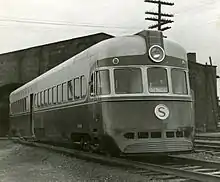

.jpg.webp)
The New York, Susquehanna and Western Railway can trace its roots back to the failed New Jersey, Hudson & Delaware Railroad (NJH&D), chartered in 1832 to connect industrial Paterson, New Jersey, east to the ports along the Hudson Waterfront opposite New York City at Hoboken and west to Pennsylvania at the Delaware Water Gap.[8] Several competing companies sprang up in 1867 to make routes through this corridor, but the New Jersey Western Railroad (NJW) was the most successful, constructing westward from Paterson and Hawthorne. In 1866, the New York and Oswego Midland Railroad (NY&OM) was chartered to connect the Great Lakes port at Oswego, New York, with New York City. Construction on the NY&OM started in 1868 and progressed rapidly. The creation of this company prompted the NJW to shift its focus towards connecting to this route. Cornelius Wortendyke, president of the NJW, signed a lease agreement with DeWitt Clinton Littlejohn of the NY&OM giving his road a through route into New Jersey. Construction on the NJW had stretched from Hackensack, New Jersey all the way through to Hanford by the time it changed its name to the New Jersey Midland Railway (NJM) in 1870 and consolidated with three other competing companies, including the NJH&D.[9]
The NY&OM reached Middletown, New York, and leased the connecting Middletown, Unionville and Water Gap Railroad (MU&WG), which reached the NJM at Hanford. The last stretch of construction from Hackensack to Jersey City completed the NJM in 1872. The first through train from Oswego to Jersey City operated on July 9, 1873. While the goals of the two partners had been reached, the Panic of 1873 caused financial ruin for both companies. The NY&OM suspended lease payments, and the agreement was broken. The NY&OM was reorganized as the New York, Ontario and Western Railway in 1879, and went its separate way. The NJM took over the lease of the MU&WG as well. Unable to weather the financial storm, the NJM was put into receivership in 1875.[9] In 1880, the NJM was reorganized as the New Jersey Midland Railroad (NJM), and attention was once again turned to the lucrative coal fields of eastern Pennsylvania.
Formation and as an independent railroad
In 1881, the New Jersey Midland Railroad was consolidated with five other railroads to form the New York, Susquehanna and Western Railway. The new New York, Susquehanna and Western Railway had extended west to Gravel Place, Pennsylvania, and a connection with the Delaware, Lackawanna and Western Railway (DL&W). The NYS&W also had a connection to the DL&W at Delaware, New Jersey via the Blairstown Railway. Due to the increased volume of traffic, the railroad was double-tracked from Paterson to Jersey City in 1887. To reach the port on the Hudson River waterfront, traffic was handed off to the Pennsylvania Railroad at Marion Junction via the Hudson Connecting Railway. To keep more of the line haul revenue for themselves, the Susquehanna extended their line from their Little Ferry Yard through the new Palisades Tunnel to a new terminal at Edgewater where they had constructed coal docks for transfer from train to boat in 1892. The NYSW also reached west of the Delaware River and leased the Wilkes-Barre and Eastern Railroad to access the Scranton area directly and divert traffic away from the Lackawanna.[10]
American financier J.P. Morgan began to take notice of this rapidly expanding coal-hauler, and quietly bought up its stock on behalf of the Erie Railroad. The railroad was leased in 1898 by the Erie, which soon after took over complete operation of the line.[8][11][12]
The NYS&W was reported as the first Class I railroad in the US to completely replace its steam locomotives with internal combustion motive power, in the form of diesel electric locomotives, in early June 1945.[13] By that time the railroad was profitably operating a suburban commuter passenger service across New Jersey, as well as being a bridge line for freight connecting to several regional carriers.[14] Motorailers were employed for passen/ger service.
The NYS&W fell on hard times during the economic recession of 1957. The NYS&W lost its western connection to the Lehigh and New England Railroad when the L&NE ceased operations in 1961, resulting in the NYS&W pulling up all its track west of Sparta Junction (which now comprises what is now known as the Paulinskill Valley Trail). Thereafter, the NYS&W sold-off its nearly new Budd passenger cars and replaced them with second-hand used equipment. Desperate to close its money-losing commuter service, the railroad's trustees offered its commuters $1,000 each to stop using the trains. Permission to end commuter service was granted in 1966. Washouts caused by Tropical Storm Doria (1971) cut off other connections, and the railroad retreated to Butler, New Jersey.
Under ownership of the Delaware Otsego Corporation
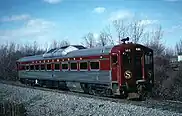
The NYS&W declared bankruptcy in 1976 after failing to pay New Jersey state taxes, though managed to stay out of Conrail, which had surrounded it. The bankruptcy court ordered that the railroad be abandoned and its assets sold. By then, the NYS&W was down to a 43-mile (69 km) line from Croxton and Edgewater through Paterson to Butler. The State of New Jersey, aware of Delaware Otsego Corporation's reputation at rehabilitating short lines, asked it to take over the railroad.
Delaware Otsego was founded in 1966 to operate a 2.6 mi (4.2 km) section of the former New York Central Railroad Catskill Mountain Branch outside Oneonta, New York. This was the first of many cast-off short line acquisitions. Between 1971 and 1986, D.O. acquired several other branches and short lines, including the Cooperstown Branch of the Delaware & Hudson Railway in 1971; the Richfield Springs Branch of the Erie Lackawanna Railway (EL) in 1973; the Fonda, Johnstown and Gloversville Railroad in 1974 and the EL Honesdale Branch in 1976.[11]
In 1980, the Delaware Otsego Corporation purchased the New York, Susquehanna and Western Railway.[11]
In 1988, Guilford Transportation Industries, (now Pan Am Railways), then owner of The Delaware and Hudson Railway, declared that road bankrupt and abandoned it after two nasty labor strikes. The New York, Susquehanna and Western Railway was ordered by the federal government to operate the D&H until a new buyer could be found. In 1990, CP Rail (now Canadian Pacific) bought the Delaware & Hudson Railway System.
1990 saw the NYS&W end service on its Edgewater Branch, a 1.5-mile (2.4 km) long line connecting its former Hudson River terminal with the mainline in Fairview at Undercliff Junction. As of 2008, the tunnel carries a pipeline owned by the Amerada Hess Corporation.
In 1994, Onondaga County, New York purchased the former Delaware, Lackawanna and Western Railroad (DL&W) line into Syracuse, with the provision that the NYS&W operate RDC service in Syracuse between Syracuse University, Armory Square and the Carousel Mall, with the option for further routes, leading to the creation of OnTrack. With operations on this segment, the Syracuse branch was rehabilitated and the Conrail interchange relocated. Regular steam excursions were offered and RDCs refurbished for OnTrack use. Intermodal trains rolled beyond Binghamton to Syracuse for interchange with Conrail. After a few years, regular excursions were halted.
New ownership
With the impending break-up of the Conrail system to Norfolk Southern Railway and CSX Transportation, the NYS&W was a ripe target for acquisition, as it could potentially siphon lucrative traffic away from either road. On October 3, 1997, DOCP Acquisition LLC announced it had completed the short-form merger of Delaware Otsego Corporation (NASDAQ:DOCP) with a wholly-owned subsidiary via a stock tender offer of $22 per share.[16]
This deal essentially brought the New York, Susquehanna & Western Railway (NYS&W), under control of Norfolk Southern and CSX, as DOCP Acquisition LLC was owned 10% by Norfolk Southern, 10% by CSX and 80% by Walter G. Rich of the Delaware Otsego Corporation.[17]
In 2005, the NYS&W leased the former Erie Main Line from Port Jervis to Binghamton from Norfolk Southern. Leased and operated under the name Central New York Railroad (CNYK), the CNYK is a "paper" railroad and all train operations and line maintenance is performed by Susquehanna personnel, while Norfolk Southern Railway retains overhead trackage rights. As of July, 2023, there are only 4 trains a week operated by the NYS&W on the line, two in each direction. The Stourbridge Railroad (SBRR) depends on the NYS&W for interchange at Lackawaxen, Pennsylvania.
In 2006, NYSW's Utica Main Line had major storm damage. The storm damage washed out sections of track in Chenango County putting the branch to Utica out of service. NYS&W continued serving customers on the line in the Utica area and south to Sangerfield from the CSX connection in Utica. In 2011, a project to restore the line was started by the Chenango County Industrial Development Agency with funding by the agency, Chenango County, the New York State Department of Transportation, and the federal Economic Development Administration. Work began in March 2016 with the clearing of brush along the 45.5-mile (73.2 km) right-of-way in Chenango County. Subsequent work included filling in washouts, replacing ties, resurfacing bridge decks, repairing and reactivating crossing signals, and other repairs. The restoration project was completed and rail service restored in May 2017.[18]
On August 9, 2007, Delaware Otsego founder Walter Rich died of pancreatic cancer.[19] After Rich's death, the new president, Nathan Fenno, canceled all passenger operations and excursions and the fleet used on them was sold-off. Many older diesel locomotives were sidelined, retired and sold during this time as well.
In July 2011, NYS&W took possession of five leased CEFX locomotives, to ease the railroad's continually worsening power shortage. These five locomotives were used as a supplement to its current EMD 645 fleet in road train service, and occasionally on local duty. It was not uncommon to see road train line-ups consisting of entirely-leased power.
In 2021, the railway formally abandoned the Lodi and Passaic branch lines.[20]
Passenger service restoration
The Bergen-Passaic Rail Line was a New Jersey Transit initiative in the mid-2000s, studying restoration of passenger service on a segment of NYS&W trackage between Sparta and Hackensack, New Jersey to alleviate traffic congestion on Route 23. The project encountered delays when a suitable location for a NJ Transit rail storage yard in or near Sparta could not be agreed upon. In October 2015, U.S. Congressman Bill Pascrell joined state legislators in creating a coalition to revive the project,[21] and in January 2016 the local governments of the involved municipalities passed concurrent resolutions to restart the project.[22]
New FRA-compliant diesel multiple unit rail cars will be used.[23][24][25] The project has been promoted via social networking blogs and Facebook,[26] resulting in Kinnelon officials publicly voicing support for the project.[27]
Chinese steam operations and history
.jpg.webp)
In the 1990s, NYS&W President Walter Rich wanted a China Railways SY type steam locomotive. The engine purchased, SY 1698M, was to be NYS&W #141, delivered eventually to Syracuse, New York. Transport was to be by cargo ship from the Tangshan Works in China via the Indian Ocean. Due to the Gulf War, shipment was delayed for several months. Then, the Norwegian freighter M/V Braut Team encountered a major cyclone in the Indian Ocean, flooded and sank on June 7, 1991, in the Bay of Bengal with all cargo lost.[28][29]
After the loss of #141, NYS&W made an offer to the Valley Railroad to purchase their Tangshan-built SY #1647 steam locomotive, which the Valley Railroad accepted in 1992.[30] The engine, altered and painted to look like a 1920s-era engine, was lettered and renumbered to #142, the next locomotive after the lost #141. The engine made runs throughout the NYS&W system, participating in such events such as the Steamtown National Historic Site grand opening in 1995,[31] the Dunellen Railroad Days and Lincoln Park Railroad Days. The engine also has double-headed with other steam locomotives, such as Chesapeake & Ohio#614 and Milwaukee Road#261. The engine is now operated by the Belvidere and Delaware River Railway for tourist excursions along the Delaware River. The locomotive was pulled from service in late 2017 for a rebuild, which had not yet been completed as of late 2022.[32]
Connections with other railroads
- The railroad has connections with two Class I railroads:[33]
- CSX Transportation - Syracuse, New York; Utica, New York; North Bergen, New Jersey
- Norfolk Southern Railway - Binghamton, New York, Marion Junction (New Jersey) and the Passaic Junction (rail yard) rail yard in Saddle Brook, New Jersey
- The railroad has connections with five other railroads:
- Morristown & Erie Railway and New Jersey Transit - Passaic Junction (rail yard), Saddle Brook, New Jersey
- Middletown and New Jersey Railroad - Warwick, New York
- Finger Lakes Railway - Syracuse, New York
- Mohawk, Adirondack and Northern Railroad (MHWA) - Utica, New York
- Stourbridge Railroad - Lackawaxen, Pennsylvania
Stations
| State | Location | Station | Miles (km) | Date opened |
Date closed |
Notes |
|---|---|---|---|---|---|---|
| NJ | Jersey City | Pavonia Terminal | 0.0 miles (0 km) | December 1, 1911[34] | December 12, 1958[35] | Until December 1, 1911, the railroad used the Pennsylvania Railroad's Exchange Place Terminal.[34] |
| North Bergen | Susquehanna Transfer | August 1, 1939[36] | June 30, 1966[37] | From December 13, 1958–June 30, 1966, Susquehanna Transfer served as the southern terminus of the railroad. The station shared service with the Erie Railroad Northern Branch. | ||
| North Bergen | 6.0 miles (9.7 km) | June 30, 1966[37] | Shared service with the Erie Railroad Northern Branch | |||
| New Durham | 6.9 miles (11.1 km) | March 11, 1872[38] | June 30, 1966[37] | Shared service with the Erie Railroad Northern Branch | ||
| Northern Branch forks off at Granton Junction | ||||||
| Babbitt | 8.5 miles (13.7 km) | June 30, 1966[37] | ||||
| Ridgefield Park | Little Ferry | 11.1 miles (17.9 km) | June 30, 1966[37] | Name of station (and associated freight yard) derived from Little Ferry, the ferry service that formerly operated across the Hackensack River here; the municipality of Little Ferry on the other side of the river was also named for the ferry service. | ||
| Ridgefield Park | 11.8 miles (19.0 km) | March 11, 1872[38] | June 30, 1966[37] | Station co-served with the West Shore Railroad of the New York Central Railroad until they discontinued passenger service on December 10, 1959.[39] The original wooden passenger station was replaced by an ornate brick structure that opened on August 20, 1927.[40] | ||
| Bogota | Bogota | 13.2 miles (21.2 km) | March 11, 1872[38] | June 30, 1966[37] | ||
| Hackensack | Hackensack | 13.9 miles (22.4 km) | March 11, 1872[38] | June 30, 1966[37] | ||
| Prospect Avenue | 14.6 miles (23.5 km) | June 30, 1966[37] | ||||
| Lodi Branch forked off west of Prospect Avenue | ||||||
| Maywood | Maywood | 15.3 miles (24.6 km) | March 11, 1872[38] | June 30, 1966[37] | ||
| Rochelle Park | Rochelle Park | 16.1 miles (25.9 km) | June 30, 1966[37] | |||
| Saddle Brook | Passaic Junction | 17.4 miles (28.0 km) | ||||
| Passaic Branch forked off at Passaic Junction | ||||||
| East Paterson | East Paterson | 18.6 miles (29.9 km) | March 11, 1872[38] | June 30, 1966[37] | The station was known as Dundee Lake until October 1928, 12 years after the borough changed names to East Paterson.[41] Damaged in a fire on October 13, 1969, the railroad demolished the station soon after.[42] East Paterson changed its name to Elmwood Park on January 1, 1973. | |
| Paterson | Vreeland Avenue | 19.3 miles (31.1 km) | June 30, 1966[37] | The railroad demolished the original wooden Vreeland Avenue station in 1949 and replaced it with a brick structure that opened in September.[43] | ||
| Broadway-Paterson | 20.5 miles (33.0 km) | March 11, 1872[38] | June 30, 1966[37] | The station served as junction to the Paterson City Branch, which discontinued service on January 8, 1960.[44] The station, abandoned for 12 years, burned on June 24, 1978.[45] | ||
| Paterson City Branch forked off to Paterson City station. | ||||||
| Riverside | 21.9 miles (35.2 km) | March 11, 1872[38] | June 30, 1966[37] | |||
| Hawthorne | Hawthorne | 22.8 miles (36.7 km) | March 11, 1872[38] | June 30, 1966[37] | ||
| North Hawthorne | 23.4 miles (37.7 km) | March 11, 1872[38] | June 30, 1966[37] | The station at North Hawthorne was first known as Van Winkles, named after a local family who donated the land for the new station and railway. Despite protests from the family, the Susquehanna moved the station to its modern location on May 24, 1891, when the railroad changed the name to North Paterson. The name changed again in 1923 to North Hawthorne.[46] | ||
| Midland Park | Midland Park | 25.2 miles (40.6 km) | March 11, 1872[38] | June 30, 1966[37] | Midland Park station burned on August 28, 1985, while serving as a furniture stripping company building.[47] | |
| Wortendyke | 26.5 miles (42.6 km) | March 11, 1872[38] | June 30, 1966[37] | Wortendyke served as the home of the car repair shops until a fire on December 27, 1891. The shops were not rebuilt at Wortendyke, but moved to North Paterson station in 1892.[46] | ||
| Wyckoff | Wyckoff | 28.0 miles (45.1 km) | March 11, 1872[38] | June 30, 1966[37] | ||
| Franklin Lakes | Campgaw | 29.7 miles (47.8 km) | March 11, 1872[38] | June 30, 1966[37] | ||
| Crystal Lake | 30.7 miles (49.4 km) | March 11, 1872[38] | ||||
| Oakland | Oakland | 32.0 miles (51.5 km) | March 11, 1872[38] | June 30, 1966[37] | Oakland station came down on November 25, 1957, to be replaced by a post office that included a small area for a railroad office.[48] | |
| West Oakland | ||||||
| Pompton Lakes | Pompton Lakes | 35.0 miles (56.3 km) | March 11, 1872[38] | June 30, 1966[37] | ||
| Pompton Junction | 35.6 miles (57.3 km) | January 1, 1873[49][50] | This station marked a junction with the Erie Railroad's New York and Greenwood Lake Railway. The abandoned station burned to the ground on May 8, 1941.[51] | |||
| Riverdale | Bloomingdale | 36.8 miles (59.2 km) | March 11, 1872[38] | Despite being named after the borough of Bloomingdale, the station was actually in nearby Riverdale. | ||
| Butler | Butler | 38.0 miles (61.2 km) | March 11, 1872[38] | June 30, 1966[37] | Formerly known as West Bloomingdale, Butler served as the northern terminus of commuter passenger service until its discontinuation on June 30, 1966.[37] | |
| West Milford | Smiths Mills | 39 miles (63 km) | March 11, 1872[38] | |||
| Wharton and Northern Railroad merges with the railroad at Green Pond Junction | ||||||
| Charlotteburgh | 43.4 miles (69.8 km) | March 11, 1872[38] August 7, 1942[52][53] |
March 21, 1941 September 1944[54] |
|||
| Macopin Lake Branch forks off at Macopin Lake Junction | ||||||
| Newfoundland | 45.1 miles (72.6 km) | March 11, 1872[38] August 7, 1942[52] |
March 21, 1941 September 1944[54] |
|||
| Oak Ridge | 47.0 miles (75.6 km) | August 7, 1942[52] |
March 21, 1941 September 1944[54] |
|||
| Hardyston Township | Stockholm | 50.4 miles (81.1 km) | August 7, 1942[52] |
March 21, 1941 September 1944[54] |
||
| Beaver Lake | 53.9 miles (86.7 km) | August 7, 1942[52] |
March 21, 1941 September 1944[54] |
|||
| Hanford Branch forked off at Beaver Lake station | ||||||
| Ogdensburg | South Ogdensburg | 57 miles (92 km) | ||||
| Sparta | Sparta | 60.2 miles (96.9 km) | Sparta station burned in an early morning fire on September 3, 2012.[55] | |||
| Sparta Junction | 63.1 miles (101.5 km) | |||||
| Lafayette Township | Hyper-Humus | 65.9 miles (106.1 km) | Junction with the Delaware, Lackawanna and Western Railroad's Sussex Branch | |||
| Hampton Township | Halsey | 68.4 miles (110.1 km) | ||||
| Swartswood | 71.3 miles (114.7 km) | |||||
| Stillwater Township | Emmaus | |||||
| Stillwater | 75.3 miles (121.2 km) | |||||
| Frelinghuysen Township | Paulina | |||||
| Marksboro | 79.8 miles (128.4 km) | |||||
| Blairstown | Blairstown | 82.9 miles (133.4 km) | ||||
| Kalarama | 84.7 miles (136.3 km) | Citing low sales, the station at Kalarama was to be moved to Vails in a similar fashion to North Hawthorne. The station fell off the rail platform it had been moved to, tumbled down an embankment, and fell apart.[56] | ||||
| Vail | 86.5 miles (139.2 km) | |||||
| Knowlton Township | Hainesburg | 89.1 miles (143.4 km) | ||||
| Hainesburg Junction | 89.4 miles (143.9 km) | |||||
| Warrington | 91 miles (146 km) | |||||
| Delaware Branch forked off after Warrington station | ||||||
| Columbia | 91.7 miles (147.6 km) | |||||
| Pahaquarry Township | Howeys | Howeys station was a summer flag stop east of Dunnfield.[57] | ||||
| Dunnfield | 95.3 miles (153.4 km) | February 16, 1941[58] | ||||
| Delaware River | ||||||
| PA | Smithfield Township | Water Gap | 97.9 miles (157.6 km) | February 16, 1941[58] | ||
| Stroudsburg | Stroudsburg | 101.2 miles (162.9 km) | February 16, 1941[58] | |||
| Wilkes-Barre and Eastern Railroad forked off west of Stroudsburg | ||||||
| Gravel Place | 103.6 miles (166.7 km) | February 16, 1941[58] | Western terminus of NYSW | |||
Rolling stock
| Road Number(s) | Photo | Manufacturer | Model | Powertrain | Notes |
|---|---|---|---|---|---|
| 3010, 3014 |  |
EMD | SD40T-2 | Diesel–electric | In 1978, the Denver and Rio Grande Western Railroad ordered 12 EMD SD40T-2s (order #776098) numbered #5386 to #5397. The same year the Southern Pacific Railroad ordered 15 SD40T-2s
(order #776069) numbered #8307 to #8321. The engines in the order featured extended "snoot" noses for radio control equipment. Around the early to mid 1990's, D&RGW #5397 was painted in the SP "bloody nose" paint scheme after the D&RGWs Consolidation with SP but kept its original number. In 1996, after the merger into Union Pacific Railroad, #5397 was renumbered to #8589 but kept its paint scheme. After the Merger, SP #8321 stayed nearly the same having not been repainted or renumbered. Around 2002, #8589 and $8321 were sold to the Susquehanna and were renumbered to #3002 and #3014. Not long after #3002 was renumbered to #3010. In 2007 both engines were sent to American Motive Power in Dansville, NY to be repainted and rebuilt. Both engines were rebuilt to meet the 2007 EPA diesel engine emission standards. Unlike #3012 and #3016, they kept their car bodies but, #3010 was reclassified by the Susquehanna as a SD40-2. Around late 2011 to early 2012 #3010 was put out of service along with nine other locomotives (#2062, #2064, #2066, #3618, #3634, #4050, #4052, and #4054). To this day #3010 sits in storage at Binghamton yard while #3014 is operational. |
| 3012, 3016 | .jpg.webp) |
SD33ECO | In 1978, the Southern Pacific railroad ordered 75 SD40T-2's from EMD (order #786174) numbered #8499 to #8573. The SD40T-2's were perfect for SP as they were designed for mountainous areas and tunnels. In 1980, they ordered 70 more units (order #786265) numbered #8230 to #8299. Around the late 1990's to the early 2000's, #8242 and #8542 were sold to the Susquehanna. They were renumbered #3012 and #3016 but kept their SP "bloody nose" paint scheme until they were repainted in 2003. In 2007, both units were sent to American Motive Power in Dansville, NY to be rebuilt. #3012 and #3016 were rebuilt into SD33ECOs to meet the 2007 EPA diesel engine emission standards. On Thursday August 9, 2018, #3016 and three other SD60s (#3800, #3802, #3806) pulling SU-99 hit a washed out section of track at mile marker 171.87 (near Deposit, NY) and derailed. Unlike the other engines, #3016 suffered minor damage and was later returned to service. In 2020, #3012 and #3016 were fitted with Operation Life Saver New Jersey decals on both sides of their long hood. | ||
| 3018, 3022, 3024 |  |
SD40-2 | In 1978, the Southern Railroad ordered 33 SD40-2 high hood units (order #776044) from EMD numbered #3255 to #3287. In 1982, after the merger into Norfolk Southern, #3267 was painted into the black and white NS paint scheme. In the early 2000's, Big Dog Lines purchased the locomotive. The Susquehanna leased #3267 from 2002 to 2003 and later bought it in 2004 from BDLX. It was renumbered to #3018 and was later sent to AMP in Dansville, New York to be rebuilt in 2006. #3018 was rebuilt and had its nose chopped for better visibility. In 1966, the Norfolk and Western Railroad ordered 30 SD40s with high hoods from EMD (order #5707) numbered #1580 to #1609. After the 1982 merger into NS #1605 was painted into the black and white NS paint scheme. In the early 2000's, BDLX bought the locomotive and leased it to the Susquehanna from 2002 to 2003. Like #3018 they bought #1605 in 2004 and renumbered it to #3022. In 2006 #3022 was rebuilt and had its nose cut. The Susquehanna reclassified #3022 as a SD40-2 but still kept its SD40 car body. In 1979, the Burlington Northern Railroad ordered 55 SD40-2's, 39 of which were built in the US (order #786294) numbered #7167 to #7205, and 16 in Canada (order #C422) numbered #8074 to #8089. In the late 1990s to early 2000s, Helm Financial bought #7200 but never painted it. In the early to mid 2010s, NS purchased #7200 repainted and renumbered it to #3553. In late 2020, the Susquehanna purchased the locomotive and renumbered it to #3024. They painted it into the "black jacket" paint scheme which is a modified version of the Norfolk Southern's with the "S-ball" logo on the nose and with "Susquehanna" written on the side. On Monday April 17, 2023, #3024 rolled out of the Butler shops wearing a maroon and grey heritage scheme. | ||
| 3040 | GP40 | ex-CSX, commonly used on the NYSW's Utica Branch especially when switching at FX Matt Brewery. | |||
| 3618, 3634 |  |
SD45-2 | They were a bulk order of former BN SD45's. 3618 and 3634 are the only two engines that remain. 3634 was out of service up until recent years where they were put back in service. | ||
| 4060, 4062, 4064, 4066 | 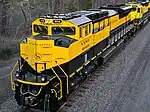 |
SD70M-2 | ex-NS, they were painted in the “Black Jacket” paint scheme up until April 26, 2023, when all were painted in the yellowjacket scheme. |
Dispositions
| Road
Number(s) |
Photo | Manufacturer | Model | Powertrain | Notes |
|---|---|---|---|---|---|
| M-1, M-2,
M-3, M-4, M-5, M-6, M-7, M-8 |
 |
Budd Company | RDC1 | Diesel– | The Susquehanna would receive two RDC1 demo cars from the Budd Company numbered #2996 and #2997. The RDC's were a success and the Susquehanna would order four of them. #2996 and #2997 would become M-1 and M-2, M-3 and M-4 would join them in October of 1950. The RDC's replaced the older Motorailers as they were much more flexible in being able to run individually or in groups. Eight years later in April 1958, they were sold to the CNJ and operated through the Conrail era up until the end of the CNJ. In the 1990's, the Susquehanna acquired four RDC's from the Metro-North numbered #18, #11, #43, and #65. The new engines M-5 through M-8 would operate the On-Track shuttle service in Syracuse, NY. M-1, M-2, and M-4 survive today and are owned by the NYS&W Technical and Historical society. M-5 survives today on Conway Scenic Railroad as the #23. M-7 survives today on the Reading Blue Mountain and Northern Railroad as #9167. M-8 survives today in disrepair on the Wisconsin Great Northern Railroad as the #8. |
| 100 | N/A | Buda | Streamlined Inspection car | Gas-mechanical | In 1940, the Susquehanna purchased a four-wheel inspection car built by the Buda company. It was a small multi-person inspection locomotive used by the Susquehanna's MOW crew. In 1960, the vehicle was sold and later scrapped. |
| 101, 104 | ALCO | RS-3 | Diesel–electric | In 1952, the D&H placed an order for 25 ALCO RS-3's, part of the order would include #4088 and #4117. #4088 served the railroad for 20 years before being retired. Right before it was about to be scrapped the, Central New York Railroad bought the engine renumbering it to #101. The engine would be later painted in the D&O's burgundy and gold paint scheme. Not long after the Susquehanna acquired the locomotive, it was later painted in their iconic yellow and black paint scheme. In a deal with the Rome Locomotive Works, they would do work on some of the Susquehanna's other locomotives in return for the #101 which they would use as a shop switcher. At the shops, the locomotive would regain its original number as #4088. The #4117 ran on the D&H for nearly two decades before being sold to the United Railway Supply Co in April 1972. In October of 1937, the engine was sold to the Roberval and Saguenay Railroad as #29. Not long after the Adirondack Railroad would buy the #29 to run trains between Utica and Lake Placid, New York for the 1980 Winter Olympics. With the poor financial state of railroad, they sold the engine to the Susquehanna where they renumbered it to #104 in April 1982. In the early to mid 1990's, the #4088 and #4117 were sold to the Cuyahoga Valley Scenic Railroad and were later scrapped in 1996. | |
| 116 | EMD | NW-2 | In 1948, the New York, Ontario and Western Railroad placed an order for 21 EMD NW-2 switcher locomotives, one of those being #116. After many years operating on the NYO&W, the engine was sold to the New York Central Railroad and was renumbered to #9501. The Penn Central acquired the locomotive around the late 1960s, most likely through the PC Merger. It was renumbered to #8684 and served nearly a decade on the railroad until the creation of Conrail. Again most likely through the merger of Penn Central and multiple other failing railroads, the engine would join Conrail's fleet of locomotives being renumbered to #9264. Around the mid 1980's, #9264 was bought by a member of the Delaware Otsego's board of directors. The engine regained its original number and paint scheme and was leased to the Susquehanna. In 2009, the #116 was, "willed to the Delaware & Ulster Railroad" where it still operates today, but is in poor condition. | ||
| 120 | SW-9 | In 1953, the Chesapeake and Ohio Railroad placed an order with EMD for 35 SW-9 switcher locomotives. One of the 35 locomotives in the order was #5091. 32 years later the engine would be sold to the Susquehanna as #120. Around the late 1990s to the early 2000s, the locomotive was sold to the American Motor Power Inc as a shop switcher. The current whereabouts of the engine are unknown. | |||
| 142 | .jpg.webp) |
SY class | Tangshan Locomotive Works | In 1989, a 2-8-2 Mikado type steam engine was built for the Valley Railroad by the Tangshan Locomotive Works in Tangshan, China. It was numbered #1647 and only ran for two years. In 1991, the Susquehanna purchased a near identical locomotive numbered #141. On June 7, 1991, the Norwegian freighter (Braut Team) which was carrying #141, encountered a major cyclone and sank in the Bay of Bengal. Undeterred by the loss of #141, NYS&W President Walter Rich made a offer to buy the Valley Railroad #1647 in 1992. They excepted the offer, it was renumbered to #142 and painted to resemble a 1920's-era engine. It would pull multiple excursion trains attending events such as the Steamtown grand opening in 1995, the Dunellen Railroad Days, and the Lincoln Park Railroad Days. #142 has double-headed with Milwaukee Road #261, Chesapeake & Ohio #614, Delaware Lackawanna & Western #807 and #808, and NYS&W #2400 and #2402. Today, #142 operates on the Belvidere and Delaware River Railway running excursion trains along the Delaware river. | |
| 150, 151 | 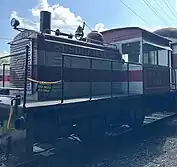 |
Whitcomb | 20T | Gas-mechanical | The small four-wheel locomotives were originally built for the Army (#7720 and #7723) in 1942 by Whitcomb. The engines were later sold to the Susquehanna in 1946. They were used to switch Seatrain cars at the Susquehanna's Edgewater Terminal. In 1960, the two engines were sold, #150 is preserved today at the Whippany Railroad Museum. The whereabouts of #151 are unknown. |
| 202, 203,
204, 205, 206, 208 |
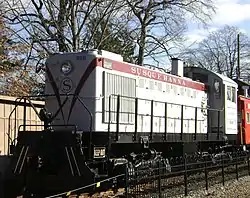 |
ALCO | S2 | Diesel–electric | At about the same time as the Susquehanna purchased the RS-1's (1941-42), they also received six S2 switchers (#202-206, #208) from ALCO. #203 and #205 are the only engines from the order that do not have M.U. capabilities. Every S2 switcher was scrapped where they sat at Little Ferry except for #206 which sits at the Maywood Station Museum. |
| 230,231(2),
232,233(2), 234, 236, 238, 240, 242, 244, 246, 248, 250, 252, 254, 256 |
.jpg.webp) |
RS-1 | In 1941, the Susquehanna ordered two RS-1's, being #231 and #233. The model had just been introduced that year by ALCO only producing 13. The two engines only saw a few months of service before World War II broke out and the units were requisitioned by the government. #231 returned to the United States later as a Navy unit while #233 would end up on the US owned Alaska Railroad. When the government allowed ALCO to resume domestic production, a new #231 and #233 were produced for the Susquehanna. In 1944, the Susquehanna would order eight more units (#230-244, even only). In 1947, they would order an additional four engines (#246-252, even only). Again in 1953, the Susquehanna would order their last two RS-1's (#254 and #256). The Susquehanna's original two engines (#231 and #233, including the remakes) were their only RS-1's to have odd numbers as they did not have the M.U. feature. On Monday, April 19, 1976, #252 rolled out of the Little Ferry roundhouse wearing its new bicentennial paint scheme to commemorate the United States Bicentennial. #252 would keep its new look up until the early 1980's were it was painted back into the "yellow jacket" paint scheme. The #231(1) survives as the US Army #8000. The #246 survives today as the Atlantic Coast Line #1846. | ||
| 1001,1002,
1003-1004, 1005-1006 |
 |
ACF | Motorailer | Diesel– | Looking to cut costs the court appointed trustee of the Railroad, Walter Kidde ordered ACF Motorailers #1001 and #1002.Seeing the success of the Motorailers four more were bought second hand from the Illinois Central Railroad numbered #1003-1004 and #1005-1006. They were bi directional semi-permanently coupled two car sets. On January 20, 1946 #1001 caught fire at Passaic Junction and was completely destroyed. Every Susquehanna Motorailer is confirmed as scraped. |
| 1800,1802,
1804 |
EMD | GP18 | Diesel–electric | In 1961 EMD sent the Susquehanna four GP20 demonstrator units (#5625-#5628). In 1962, they secured a Federal loan for the purchase of three GP18's instead of the GP20's as they did not have Turbocharger and were easier to fix. As per the Susquehanna's numbering system all three of the GP18's had M.U. capabilities. All three units survive today operating on the East Penn Railroad keeping the same numbers they had on the Susquehanna. | |
| 2400, 2402 | .jpg.webp) |
E9 | In 1954, six EMD E9's (#9990-9995) were built for the Chicago, Burlington and Quincy Railroad as part of EMD order 2065A. A year later, the CB&Q placed an order for 10 more engines (#9985A/B-9989A/B). In March of 1970, CB&Q #9991 and #9985 became BN #9921 and #9915 as part of the merger of several railroads into the Burlington Northern Railroad. In the early-mid 1990's, both engines were sold to the Susquehanna and were renumbered to #2400 and #2402. The two engines pulled multiple passenger and excursion trains including excursions with #142 and CP#2317 during the grand opening of the Steamtown National Historic Site. In mid 2000's, the two units were sidelined due to mechanical issues. Not long after they were sold to Larry's Truck and Electric and were moved to McDonald, Ohio. In 2013, #2400 and #2402 were sold to the San Luis and Rio Grande Railroad. They now sit on the Cape Cod Central Railroad in Hyannis, #2402 is currently being used for parts to repair #2400. | ||
| 3001 | .jpg.webp) |
J. G. Brill | Model 250 | Gas– electric | With the success of other Doodlebugs, the Susquehanna purchased #1171 from the Boston and Maine on November 23, 1940. |
| 3002 | N/A | Purchased from the Cumberland & Pennsylvania RR, it was built in 1929 as #101. When the Western Maryland bought the C&P they shut down their passenger service the #101 was sold to the Susquehanna. | |||
| 3636, 3638 | EMD | F45 | Diesel–electric | In 1971 the Burlington Northern ordered 20 EMD F45 locomotives (order #5774) which were numbered #6626-#6645. The reason why they went with the full-width body locomotives was to protect the crew and the engine from the harsh winter conditions. Because of the poor rear visibility almost all of the units were retired by1980s. #6640 and #6644 were later sold to the Susuqheanna. (to be continued) | |
| 5012 | Electro-Motive/Bethlehem Steel | Stillwell baggage coach
motorcar |
Gas– electric | The car was part of a joint project between EMC and BSC as part of an order for 11 cars. It was put into service on the Erie as #5012 in the late 1930's. It was leased to the Susquehanna but was later returned in 1944 as they had acquired additional railcars and diesels. It survives today at the Ohio Railway Museum and is the only known surviving Susquehanna EMC Doodlebug. |
Gallery
 EMD SD40T-2 #3012 at Butler, New Jersey
EMD SD40T-2 #3012 at Butler, New Jersey.jpg.webp) GE B40-8 #4002 passes under the Erie RR coaling tower at Susquehanna, Pennsylvania April 1989
GE B40-8 #4002 passes under the Erie RR coaling tower at Susquehanna, Pennsylvania April 1989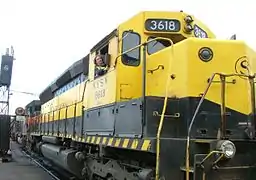
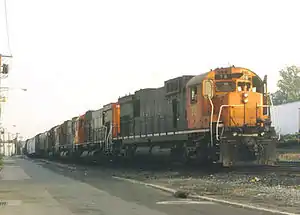 ALCO C636 #3660 at Ridgefield Park, New Jersey, September 2005
ALCO C636 #3660 at Ridgefield Park, New Jersey, September 2005.jpg.webp) ALCO RS-1 #236 suburban commuter train at Hackensack, New Jersey, September 1965
ALCO RS-1 #236 suburban commuter train at Hackensack, New Jersey, September 1965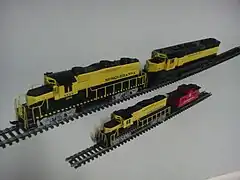 N and HO scale model trains representing the NYS&W
N and HO scale model trains representing the NYS&W Paulinskill Valley Trail by former station site in Marksboro, New Jersey
Paulinskill Valley Trail by former station site in Marksboro, New Jersey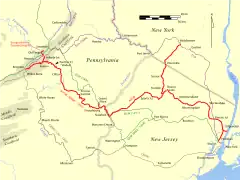 Historical route of NYS&W
Historical route of NYS&W Edgewater Terminal, circa 1900
Edgewater Terminal, circa 1900
See also
- Delaware Otsego Corporation - Parent company for NYS&W
- Susquehanna Transfer station
- Hawthorne station (New York, Susquehanna and Western Railroad)
- Maywood Station Museum
- New York, Susquehanna and Western 142
References
- "Home Page of NYSW".
- "DELAWARE OTSEGO CORP Annual Report (Regulation S-K, item 405) (10-K405) Item 2. PROPERTIES". sec.edgar-online.com. Archived from the original on 30 September 2007. Retrieved 17 January 2022.
- "Six Railroads Consolidated; The New-Jersey Midland To Be Carried Into The Coal-Fields" (PDF). The New York Times. June 12, 1881.
- Kaminski, Edward S. (January 2010). Maywood: The Borough, the Railroad, and the Station. ISBN 9780738572345.
- "The History of the N Y S & W Rai". www.nyswrailroadpolice.org. Archived from the original on 8 April 2005. Retrieved 17 January 2022.
- Archived at Ghostarchive and the Wayback Machine: ""From City To Hills"". YouTube.
- Mohowski, Robert E. (2003). The New York, Susquehanna & Western Railroad. Baltimore: JHU Press. p. 175. ISBN 9780801872228.
- Robert E. Mohowski (2003). The New York Susquehanna & Western Railroad. The Johns Hopkins University Press. ISBN 0-8018-7222-7
- Krause, John, New York, Susquehanna & Western Railroad, Carstens Publications, 1991, p. 5
- Krause, John, New York, Susquehanna & Western Railroad, Carstens Publications, 1991, p. 6
- Drury, George H. (1992). The Train-Watcher's Guide to North American Railroads: A Contemporary Reference to the Major railroads of the U.S., Canada and Mexico. Waukesha, Wisconsin: Kalmbach Publishing. pp. 173–175. ISBN 0-89024-131-7.
- "Six Railroads to Consolidate" (PDF). The New York Times. Retrieved June 5, 2012.
- Page 4, Trains magazine, August 1945
- Ashley, W.W.,"Susquehanna," Trains magazine, July 1947
- "Conway Scenic Railroad | Heritage Railway in North Conway, NH".
- "DOCP Acquisition LLC Completes Merger of Delaware Otsego Corp. – Business Wire". Archived from the original on 16 May 2011. Retrieved 17 January 2022.
- "" Docp Acquisition LLC " - Filings - Page 1". SEC Info. Archived from the original on 2012-09-14. Retrieved 2016-11-28.
- "Railroad revitalization leads to new economic opportunities in Chenango County". Retrieved 2017-09-12.
- Grace, Tom (2007-08-10). "Railroad chairman Rich dies". The Daily Star.
- "The New York, Susquehanna and Western Railway Corporation—Abandonment Exemption—in Bergen County, N.J." (PDF). Retrieved 2021-11-14.
- Higgs, Larry (October 30, 2015). "Coalition to revive Passaic, Bergen, Hudson light rail plan". NJ.com. Retrieved November 4, 2018.
- "Municipalities Pass Resolutions Supporting Passaic-Bergen Rail Project" (Press release). Passaic County. January 15, 2016. Archived from the original on June 29, 2016. Retrieved September 16, 2016.
- "NJ Transit design and engineering services for the Passaic-Bergen Passenger restoration project". Systra Consulting. Archived from the original on 2013-02-03. Retrieved 2012-05-05.
- Freemark, Yonah (May 14, 2009). "Making Links in North Jersey". The Transport Politic. Retrieved 2014-05-16.
- "Passaic-Bergen Rail Plan Advances" (Press release). New Jersey Transit. April 1, 2007. Archived from the original on 2013-05-21. Retrieved 2005-05-21.
- "Restore Passenger Service on the New York, Susquehanna and Western Rail Line". Nyswpassengerrail.blogspot.com. Retrieved 2016-11-28.
- "Kinnelon mayor wants commuter trains to return - News". NorthJersey.com. Retrieved 2016-11-28.
- Hudson, Mike; Atkins, Philip (September 2007). "Locos lost at sea. The all-time definitive record". The Railway Magazine. Vol. 153, no. 1277. IPC Media Ltd. pp. 14–19. ISSN 0033-8923.
- "The Business Times". Singapore. June 10, 1991. p. 30.
- Soloman, Brian (2012). North American Locomotives:A Railroad-by-Railroad Photohistory. Voyageur Press.
- Archived at Ghostarchive and the Wayback Machine: "PT 1 Steamtown: Grand Open. Parade of Steam". YouTube.
- "Delaware River Railroad Excursions".
- "Home Page of NYSW". Nysw.com. Retrieved 2016-11-28.
- "Erie's Fight for Terminal". The Paterson Morning Call. November 30, 1911. p. 9. Retrieved October 24, 2020 – via Newspapers.com.

- "Final Trip Slated for Erie Ferryboat". The Bergen Evening Record. Hackensack, New Jersey. December 12, 1958. p. 1. Retrieved October 23, 2020 – via Newspapers.com.

- "Modified Rapid Transit in Bergen". The Bergen Evening Record. Hackensack, New Jersey. August 1, 1939. p. 20. Retrieved October 23, 2020 – via Newspapers.com.

- "Susquehanna Commuter Service Ends". The Herald-News. Passaic, New Jersey. July 1, 1966. p. 1. Retrieved October 23, 2020 – via Newspapers.com.

- Kaminski, Edward S. (July 31, 2002). Maywood Railroad Station National Register of Historic Places Form (Report). p. 9. Retrieved October 23, 2020.
- "Weehawken-Haverstraw Line to Chug Last Mile Tonight". The Asbury Park Evening Press. December 10, 1959. p. 32. Retrieved October 23, 2020 – via Newspapers.com.

- "Ridgefield Park's New Railroad Depot Opened With Parade and Dinner". The Bergen Evening Record. Hackensack, New Jersey. August 22, 1927. p. 5. Retrieved October 23, 2020 – via Newspapers.com.

- "Railroad Station Now Has Name of Borough". The Passaic Daily Herald. October 18, 1928. p. 21. Retrieved October 23, 2020 – via Newspapers.com.

- "Railroad Station to be Demolished". The Bergen Record. Hackensack, New Jersey. November 20, 1969. p. C3. Retrieved October 23, 2020 – via Newspapers.com.

- "New Vreeland Ave. Station". The Morning Call. Allentown, New Jersey. September 29, 1949. p. 21. Retrieved October 23, 2020 – via Newspapers.com.

- "Suskie Asks Okay to Sell Paterson Land". The Paterson Evening News. January 22, 1960. p. 1. Retrieved October 23, 2020 – via Newspapers.com.

- "Station Burns". The Sunday Herald-News. Passaic, New Jersey. June 25, 1978. p. 8. Retrieved October 23, 2020 – via Newspapers.com.

- "Susquehanna R.R. Originally Designed to Bring Coal Here". The Paterson Evening News. No. Golden Jubilee Edition. June 29, 1940. p. 7-2. Retrieved October 23, 2020 – via Newspapers.com.

- Cardullo, Dana P.S. (August 29, 1985). "Volunteer Fireman, 74, is Killed in Truck Mishap". The Bergen Record. Hackensack, New Jersey. p. 28. Retrieved October 24, 2020 – via Newspapers.com.

- "RR Station Down After 87 Years". The Paterson Morning Call. November 28, 1957. p. 10. Retrieved October 24, 2020 – via Newspapers.com.

- Whittemore, Henry (1894). History of Montclair Township, State of New Jersey: Including the History of Families who Have Been Identified with Its Growth and Prosperity. New York, New York: The Suburban Publishing Company. p. 47.
- Baxter, Raymond J.; Adams, Arthur G. (1999). Railroad Ferries of the Hudson: And Stories of a Deckhand. Fordham, New York: Fordham University Press. p. 147. ISBN 9780823219544.
- "Pompton Junction Station at Riverdale Burned to the Ground". The Paterson Evening News. May 8, 1941. p. 18. Retrieved October 24, 2020 – via Newspapers.com.

- "Beaver Lake Susquehanna Stop". The Paterson Evening News. August 6, 1942. p. 35. Retrieved October 25, 2020 – via Newspapers.com.

- "ODT Allows Suskie to Give Resort Service". The Bergen Evening Record. Hackensack, New Jersey. June 30, 1943. p. 5. Retrieved October 25, 2020.
- Mohowski 2003, p. 130.
- "Sparta Train Station Burns to Rubble". The Sparta Independent. September 5, 2012. Retrieved October 28, 2020.
- Krause & Crist 1991, p. 92.
- "History along Karamac Trail: New York, Susquehanna & Western Railroad Karamac Hotel" (PDF). nps.gov. National Park Service. Summer 2003. p. 2. Retrieved October 28, 2020.
- Krause & Crist 1991, p. 97.
Other sources
- Maywood Station Historical Committee
- George Povall (1986). The New Susquehanna Great Spots for Shots.
- Krause, John; Crist, Ed (1991). Susquehanna: New York Susquehanna & Western RR. Carstens Publications. ISBN 0-911868-38-0.
- Kaminski, Edward S. (2010). New York, Susquehanna & Western Railroad in New Jersey. Arcadia Publishing. ISBN 978-0-7385-7367-0.
- Kaminski, Edward S. (2010). Maywood - The Borough, The Station, and The Railroad. Acadia Publishing. ISBN 978-0-7385-7234-5.
- Ontario & Western Railway Historical Society
- The Unofficial NYS&W Web Page
- Volunteer Railroaders Association
- Maywood Station Museum
- Southern Tier Timetable
- "THE NEW-JERSEY MIDLAND.; THE STOCKHOLDERS DEMANDING A SHARE UNDER THE REORGANIZATION." The New York Times, March 11, 1880
External links
- NYS&W Web Site — Official Corporate Site
- New York, Susquehanna & Western Technical & Historical Society
- Railfan.net NYS&W Site
- The New Jersey Midland Railway — NYS&W Early History
- Details operations at Hanford
- Photographs of the Northern Division
- Historical Photographs
- Susquehanna Surviving Locomotives and All-Time Roster.